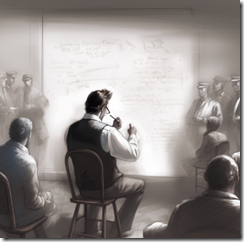Okay, Google, How Are Your Fancy Math Recommendation Procedures Working? Just Great, You Say
May 17, 2023
 Note: This essay is the work of a real and still-alive dinobaby. No smart software involved, just a dumb humanoid.
Note: This essay is the work of a real and still-alive dinobaby. No smart software involved, just a dumb humanoid.
I have no idea what the Tech Transparency Project is. I am not interested in running a Google query for illumination. I don’t want to read jibber jabber from You.com or ChatGPT. In short, I am the ideal dino baby: Set in his ways, disinterested, and skeptical of information from an outfit which wants “transparency” in our shadow age.
I read “YouTube Leads Young Gamers to Videos of Guns, School Shootings.” For the moment, let’s assume that the Transparency folks are absolutely 100 percent off the mark. Google YouTube’s algorithms are humming along with 99.999999 (six sigma land) accuracy. Furthermore, let’s assume that the assertions in the article that the Google YouTube ad machine is providing people with links known to have direct relevance to a user’s YouTube viewing habits.
What’s this mean?
It means that Google is doing a bang up job of protecting young people, impressionable minds, and those who stumble into a forest of probabilities from “bad stuff.” The Transparency Project has selected outlier data and is not understanding the brilliant and precise methods of the Google algorithm wizards. Since people at the Transparency Project do not (I shall assume) work at Google, how can these non-Googlers fathom the subtle functioning of the Google mechanisms. Remember the old chestnut about people who thought cargo planes were a manifestation of God. Well, cargo cult worshippers need to accept the Google reality.
Let’s take a different viewpoint. Google is a pretty careless outfit. Multiple products and internal teams spat with one another over the Foosball table. Power struggles erupt in the stratospheric intellectual heights of Google carpetland and Google Labs. Wizards get promoted and great leaders who live far, far away become the one with the passkey to the smart software control room. Lesser wizards follow instructions, and the result may be what the Tech Transparency write up is describing — mere aberrations, tiny shavings of infinitesimals which could add up to something, or a glitch in a threshold setting caused by a surge of energy released when a Googler learns about a new ChatGPT application.
A researcher explaining how popular online video services can shape young minds. As Charles Colson observed, “Once you have them by the [unmentionables], their hearts and minds will follow.” True or false when it comes to pumping video information into immature minds of those seven to 14 years old? False, of course. Balderdash. Anyone suggesting such psychological operations is unfit to express an opinion. That sounds reasonable, right? Art happily generated by the tireless servant of creators — MidJourney, of course.
The write up states:
- YouTube recommended hundreds of videos about guns and gun violence to accounts for boys interested in video games, according to a new study.
- Some of the recommended videos gave instructions on how to convert guns into automatic weapons or depicted school shootings.
- The gamer accounts that watched the YouTube-recommended videos got served a much higher volume of gun- and shooting-related content.
- Many of the videos violated YouTube’s own policies on firearms, violence, and child safety, and YouTube took no apparent steps to age-restrict them.
And what supports these assertions which fly in the face of Googzilla’s assertions about risk, filtering, concern for youth, yada yada yada?
Let me present one statement from the cited article:
The study found YouTube recommending numerous other weapons-related videos to minors that violated the platform’s policies. For example, YouTube’s algorithm pushed a video titled “Mag-Fed 20MM Rifle with Suppressor” to the 14-year-old who watched recommended content. The description on the 24-second video, which was uploaded 16 years ago and has 4.8 million views, names the rifle and suppressor and links to a website selling them. That’s a clear violation of YouTube’s firearms policy, which does not allow content that includes “Links in the title or description of your video to sites where firearms or the accessories noted above are sold.”
What’s YouTube doing?
In my opinion, here’s the goal:
- Generate clicks
- Push content which may attract ads from companies looking to reach a specific demographic
- Ignore the suits-in-carpetland in order to get a bonus, promoted, or a better job.
The culprit is, from my point of view, the disconnect between Google’s incentive plans for employees and the hand waving baloney in its public statements and footnote heavy PR like ““Ethical and Social Risks of Harm from Language Models.”
If you are wearing Google glasses, you may want to check out the company with a couple of other people who are scrutinizing the disconnect between what Google says and what Google does.
So which is correct? The Google is doing God, oh, sorry, doing good. Or, the Google is playing with kiddie attention to further its own agenda?
A suggestion for the researchers: Capture the pre-roll ads, the mid-roll ads, and the end-roll ads. Isn’t there data in those observations?
Stephen E Arnold, May 17, 2023



